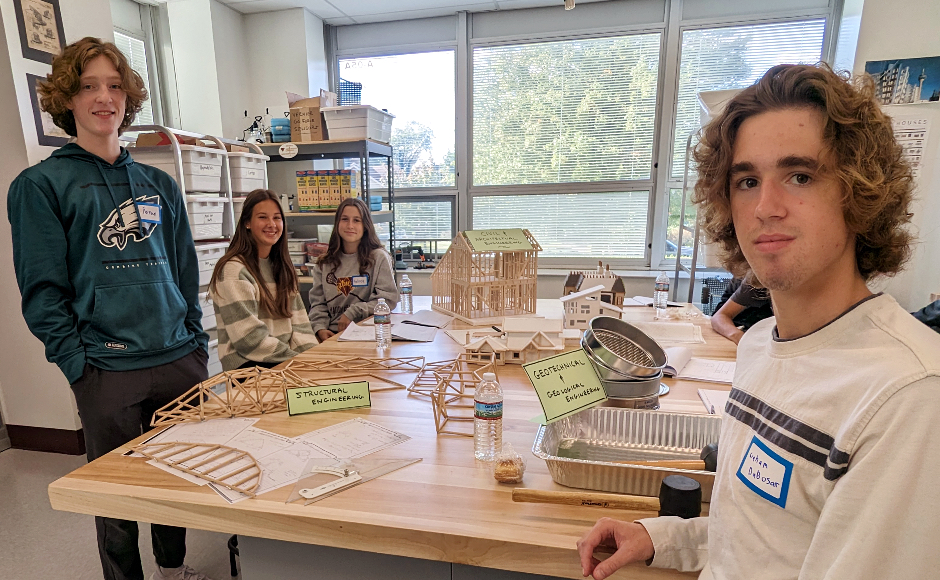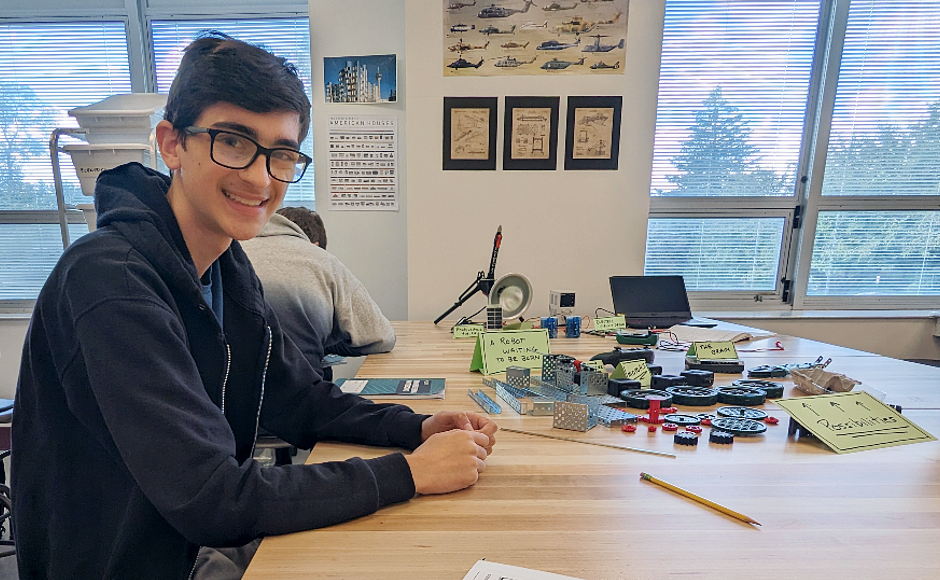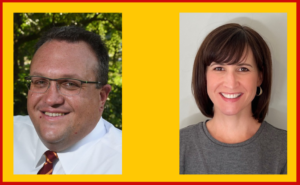By leveraging CARES Act funds in combination with local dollars, the district transforms an old garage into a state-of-the-art technological learning center.
By Matt Skoufalos | October 17, 2023
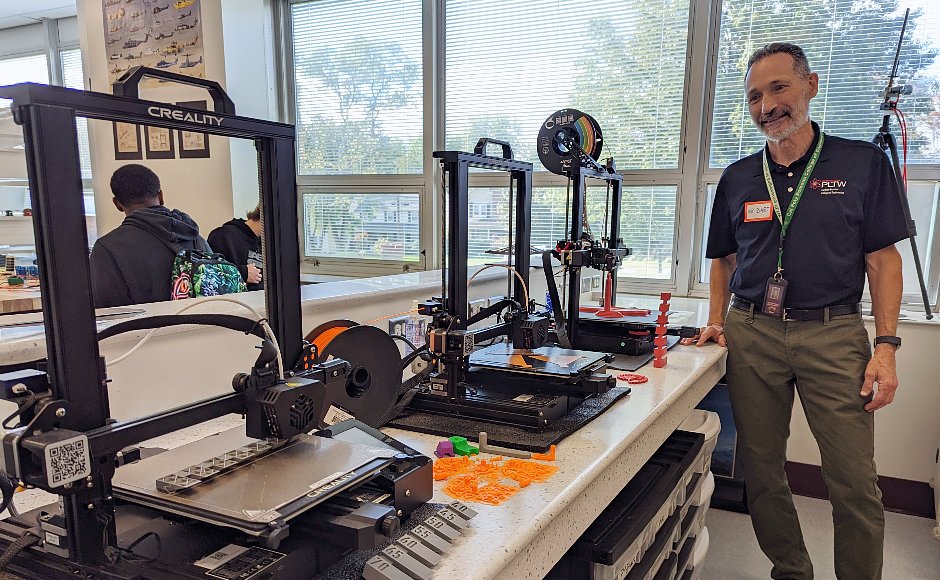
Haddon Heights High School STEM teacher Paul Bartholomew with 3D printing machines. Credit: Matt Skoufalos.
In a converted garage at a far corner of Haddon Heights High School, the next generation of engineers, architects, and roboticists is taking its formative career steps.
Thanks to an infusion of federal Coronavirus Aid, Relief, and Economic Security (CARES) Act funds and a thrifty use of local dollars, the borough public school district has transformed a darkened storage area into a high-tech classroom.
All told, the new STEM Lab — Science, Technology, Engineering, and Mathematics — cost nearly $600,000 between renovations and high-tech equipment, like 3D printers, laser cutters, and surveying tools.
But those dollars will have been well-spent if they help prepare students for engineering careers, including civil and architectural, mechanical and electrical, and robotics, Haddon Heights Superintendent Carla Bittner said.
“A couple of years ago, we were fortunate enough to hire Mr. [Paul] Bartholomew, and had this big-picture goal to create this space that is reflective of that STEM pathway,” Bittner said. “When he came to us, we used his expertise to understand what we need this space to look like.
“We care very much about preparing our students for the future, and we are very fortunate that the Board of Education is a strong proponent of this type of educational experience,” she said.
The ultimate goal of the STEM Lab is to open up other opportunities for vocational education within the district. If the lab proves successful, Haddon Heights could consider renovating an old workshop in the room next door into an additional, career-focused learning center.
“We want to expose students to opportunities in STEM, but also provide pathways for students looking into going into some form of engineering,” Bittner said. “I would love to have some culinary arts exposure, and exposure to other careers.”
Whatever form the subsequent vocational education may take, the strength of the STEM Lab turns on Bartholomew and his knack for connecting with students who have taken an interest in complex academics.
“Mr. Bart is such an exceptional teacher,” Bittner said. “His knowledge of engineering is beyond reproach. He cares about kids; he knows how to engage them. He provides opportunities that are so much more meaningful because of the way he does it.”
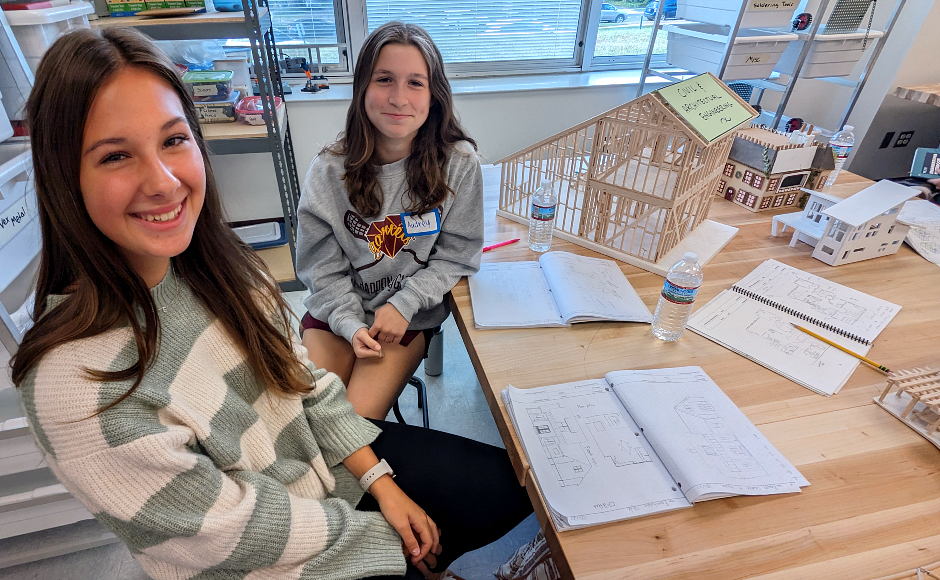
Haddon Heights High School sophomores Ellie Clapper and Audrey Kipp in the STEM Lab. Credit: Matt Skoufalos.
Senior Graham Dubosar, a boy scout who runs cross-country and loves being outdoors, said he’s enjoying the field experiences he’s had in Bartholomew’s class as much as the opportunities to engage with highly technical equipment.
“That’s what I wanted out of a program, and that’s a lot of what Mr. Bart’s doing,” Dubosar said.
“I learn way better going out and physically using the surveyor, digging up the dirt, putting together a model.”
At the beginning of the year, students worked with paper straws and paper clips; now they’re progressing to robotic equipment and 3D printers.
“It’s still early in the year, but as we keep going, I’m really excited to use all this equipment that we have now to its fullest,” Dubosar said. “It’s going to make learning a much better experience than just sitting down and doing physics.”
Last year, senior Ronan Caviston took a computer-aided design (CAD) class to learn how to make blueprints for fabrication work. Caviston, who plans to enter the welding field, said that studying architectural and engineering principles with Bartholomew have given him an understanding of how building materials work that he hopes to apply to his future career.
“If you need to fabricate something for a house, you need to know about different parts in framing, gear ratios, stress points; making sure things are structurally sound,” he said. “It’s always been appealing to me. I’ve never liked writing an essay and staying inside.”
Sophomores Ellie Clapper and Audrey Kipp are studying architectural engineering with Bartholomew. Their introduction to the class involved an inventory of different home styles, followed by a deeper look at the different design features that define each.
Clapper, who comes from a family of engineers, said the field of study has always interested her.
“I really like how this class has exposed me to it; it’s hard to get a good architecture class in a high school,” she said.
Kipp said the opportunity to be in a hands-on environment that facilitates independent learning has helped her get the most out of Bartholomew’s classes.
“Mr. Bart tells us the basis and the ideas, and then we do it ourselves,” she said.
“It’s a lot of independence, which is really nice, and it’s helped me think about what I might do in college.”
Sophomore Gabriel Raetsch enrolled in Bartholomew’s principles of engineering class because he was interested in learning more about the subject after taking a CAD class last year. So far, topics covered have included mechanical advantage, simple machines, and gear ratios.
“It’s a ton of fun,” Raetsch said. “It lets us be able to use the parts hands-on; to know not just the theory of everything, but how to be able to look at things through your hands as opposed to on a screen or a video.”
Bartholomew, whose teaching background includes degrees in science, mathematics education, and engineering, said that Haddon Heights has supported the development of his curriculum to the fullest.
“When they hired me, they said, ‘Create the engineering program that you want, and we’ll support it,” Bartholomew said.
His instruction is based on experiences at other schools, including Pennsauken High School and the Gloucester County Institute of Technology, as well as technical support from Project Lead the Way, a nonprofit institution that helps develop STEM curriculum.
Bartholomew is also a firm believer in the power of innovation through experimentation in problem-solving. When students need specialized equipment to solve problems, they can use the classroom technology to fabricate them.
“I’m trying to mimic real engineering,” he said. “When there’s parts that you don’t have, you have to design and make them.”
Likewise, by offering a curriculum that includes different forms of engineering within a yearlong class, Bartholomew hopes his instruction will unify the variety of experiences that his students might have in future course of study.
“They might be inspired for engineering, but the same design process and mentality that allows you to use all those machines… the sky’s the limit,” he said.
“I bought a home and rehabbed it myself,” Bartholomew said. “It’s the same process. You don’t have to be an engineer [to solve real-world problems].”


